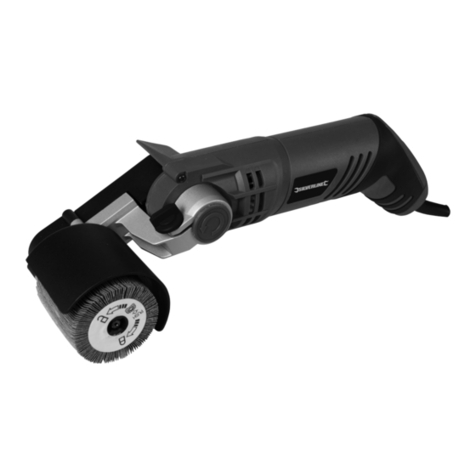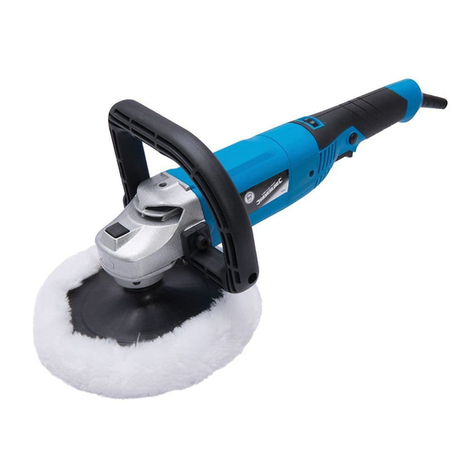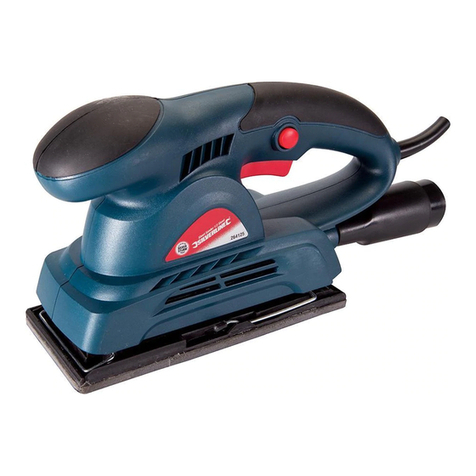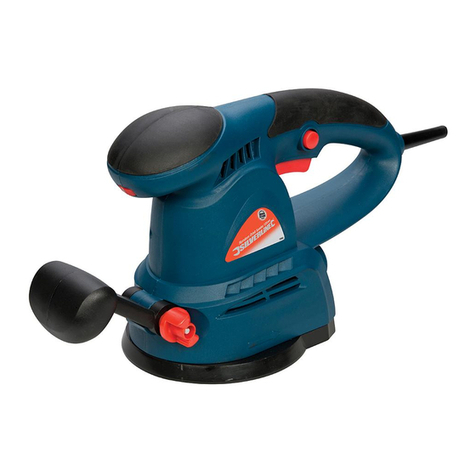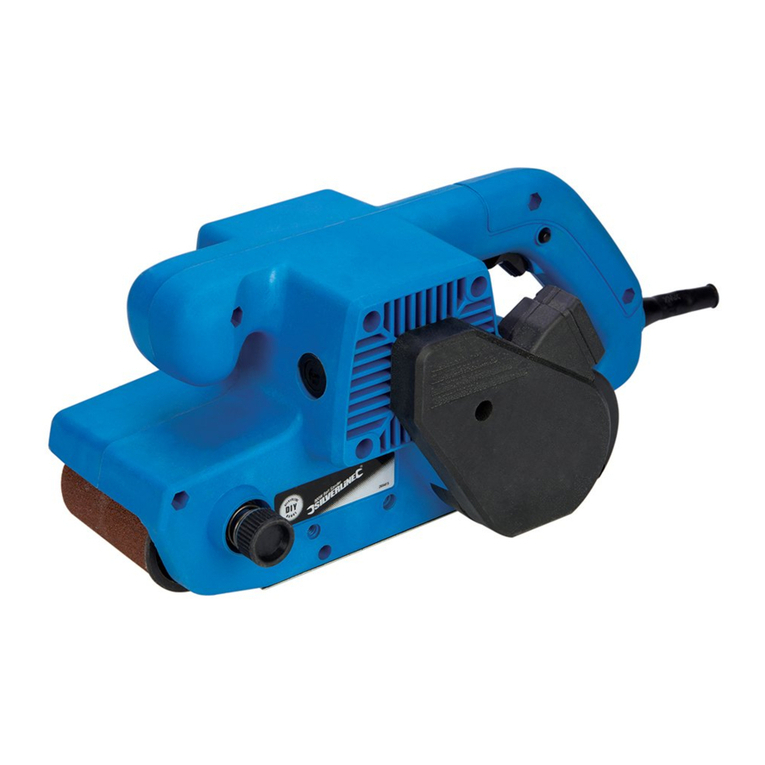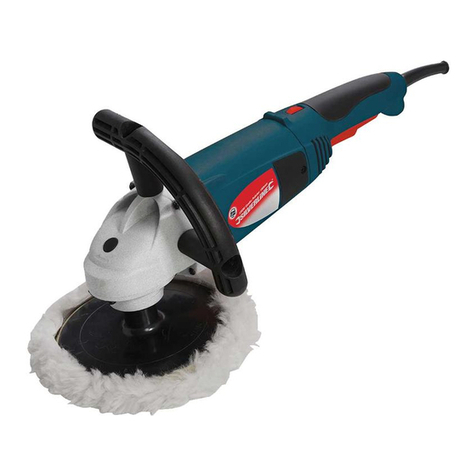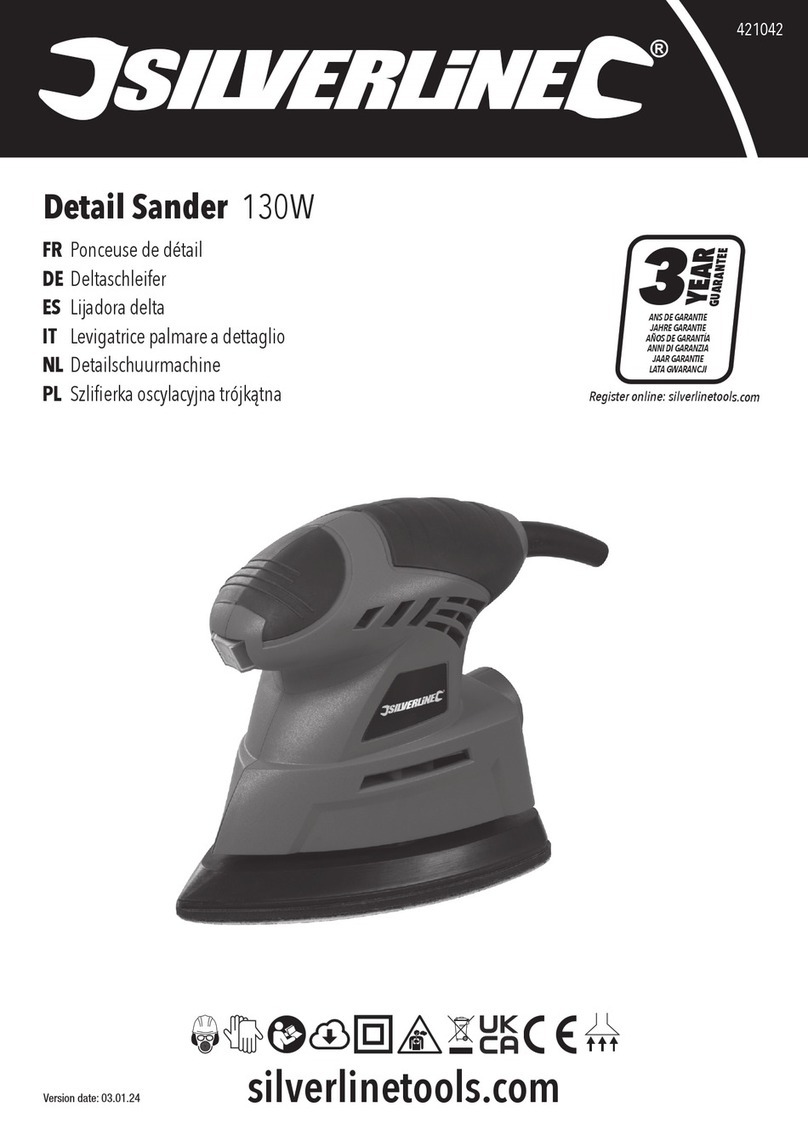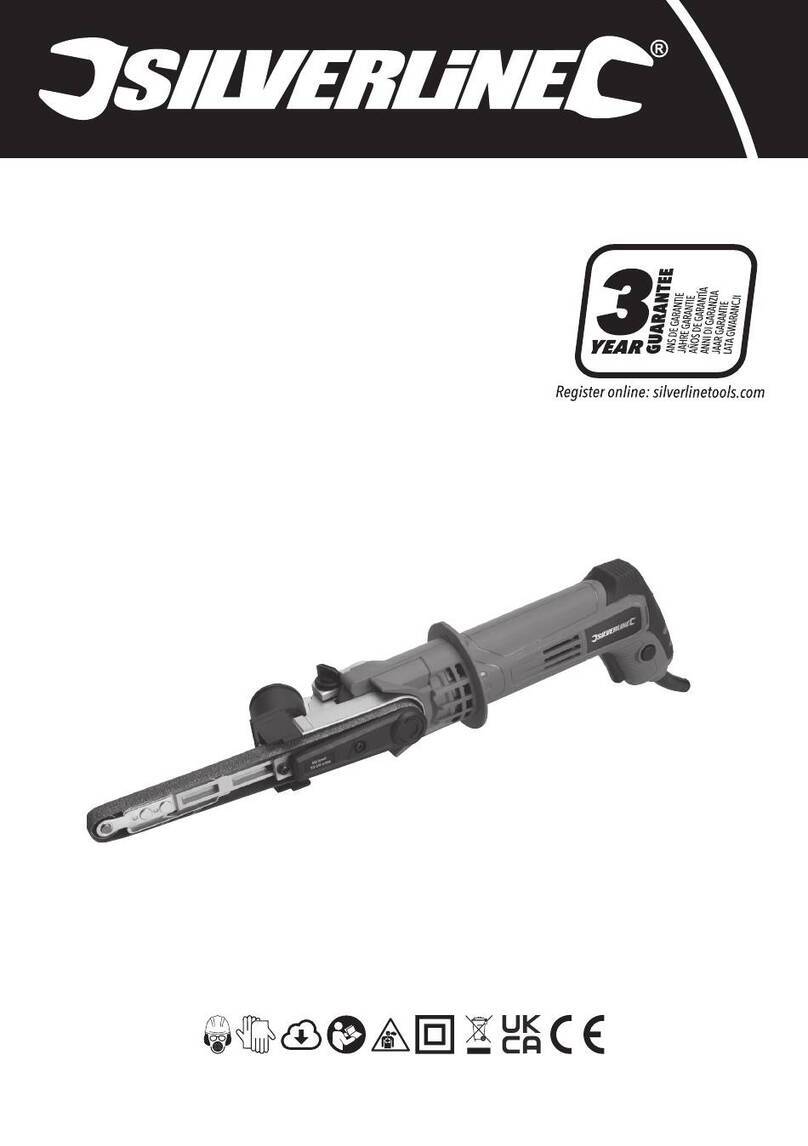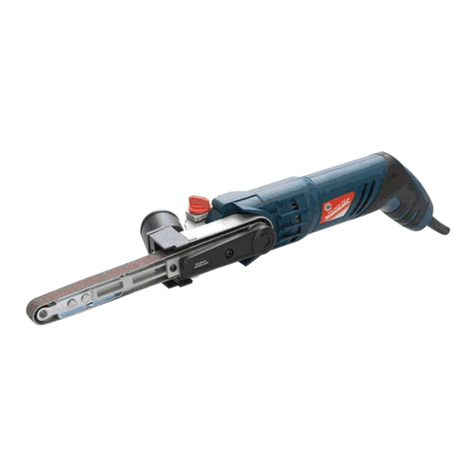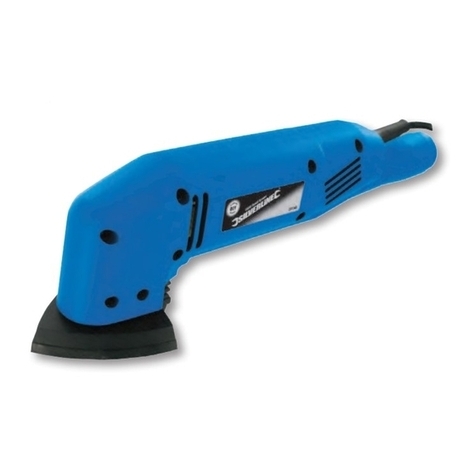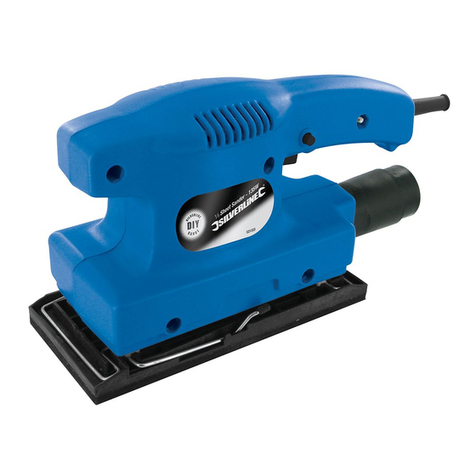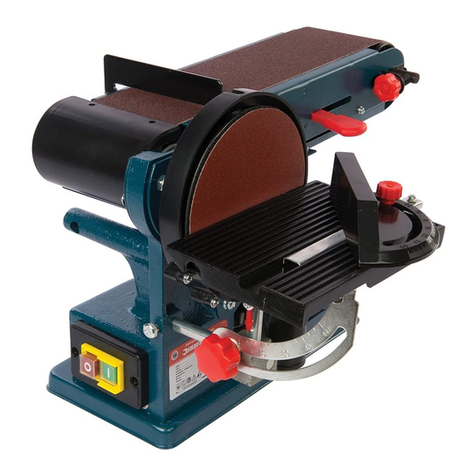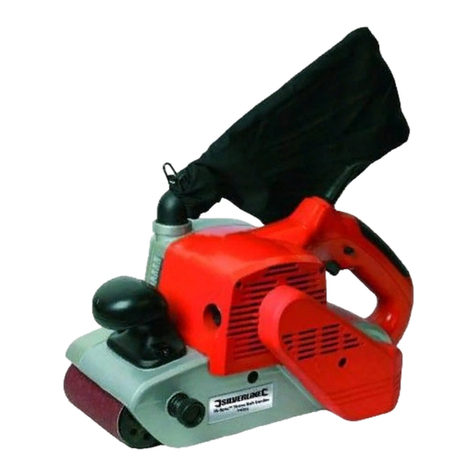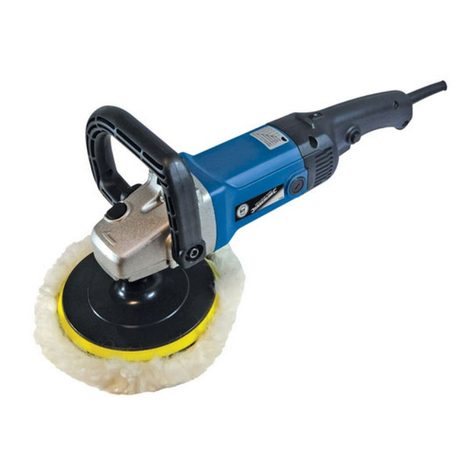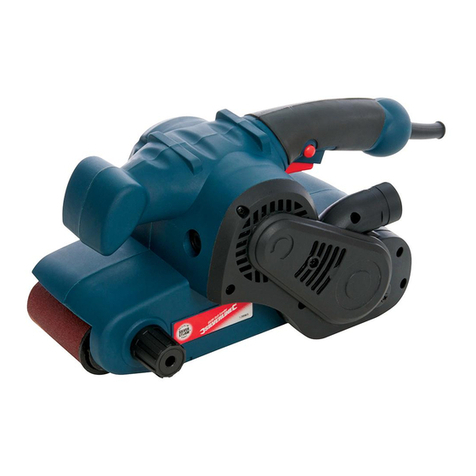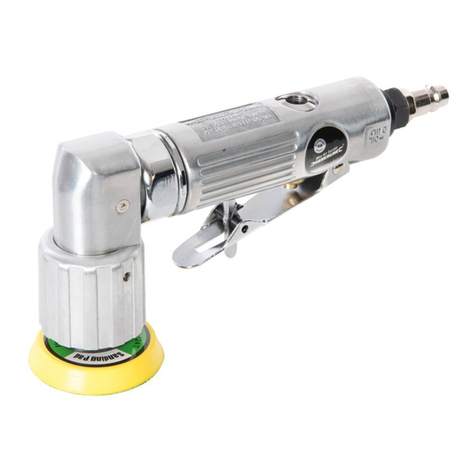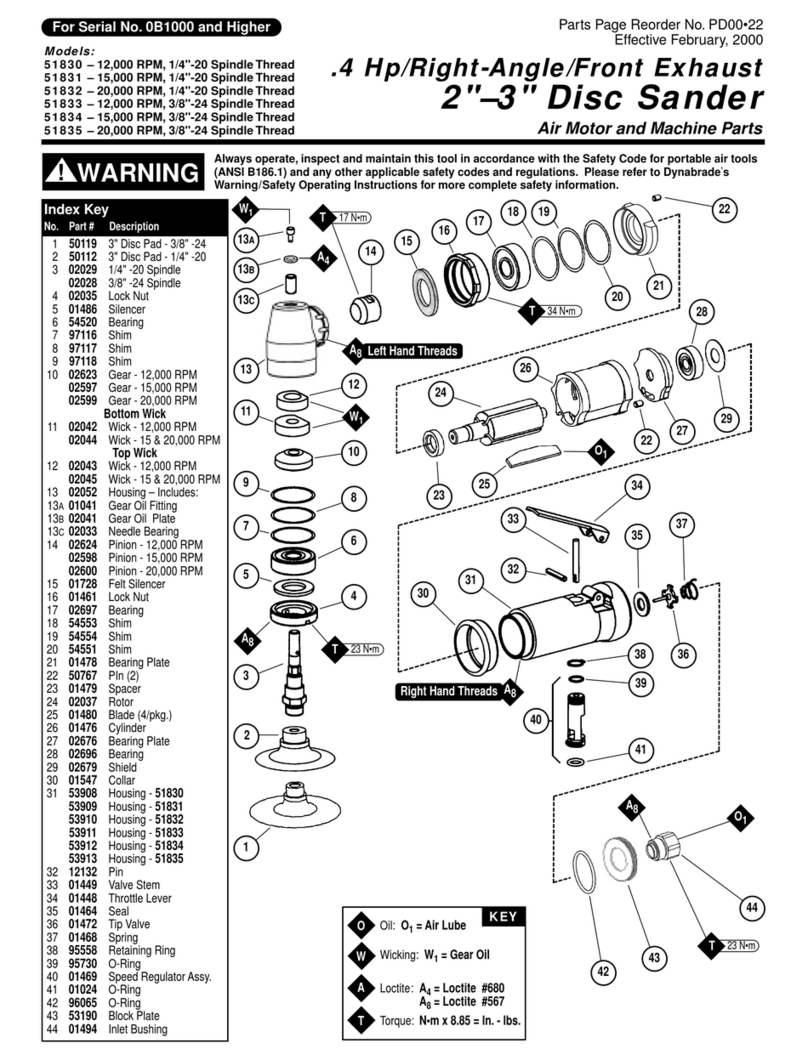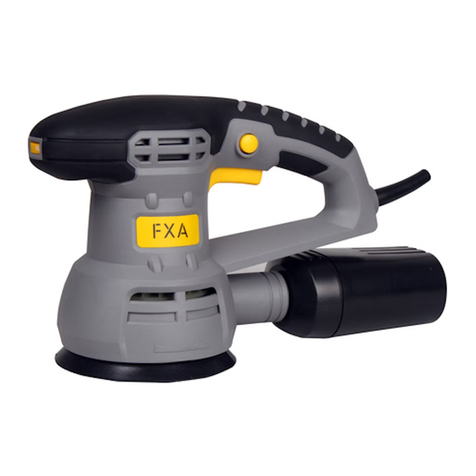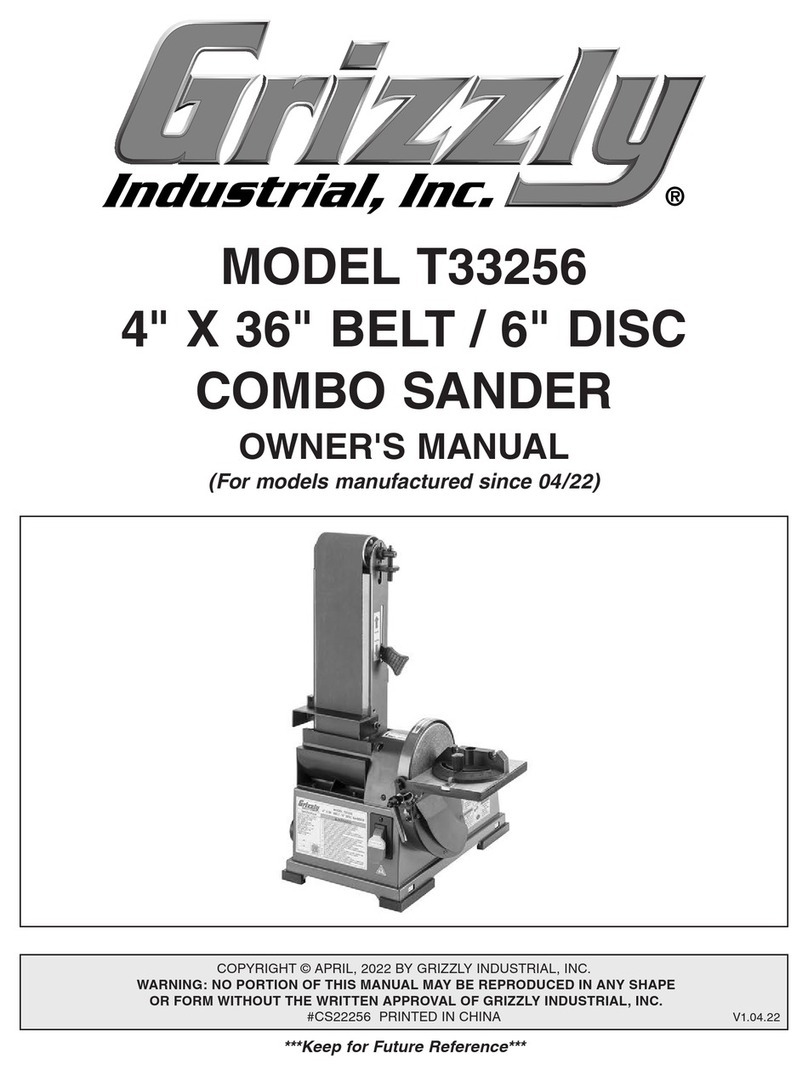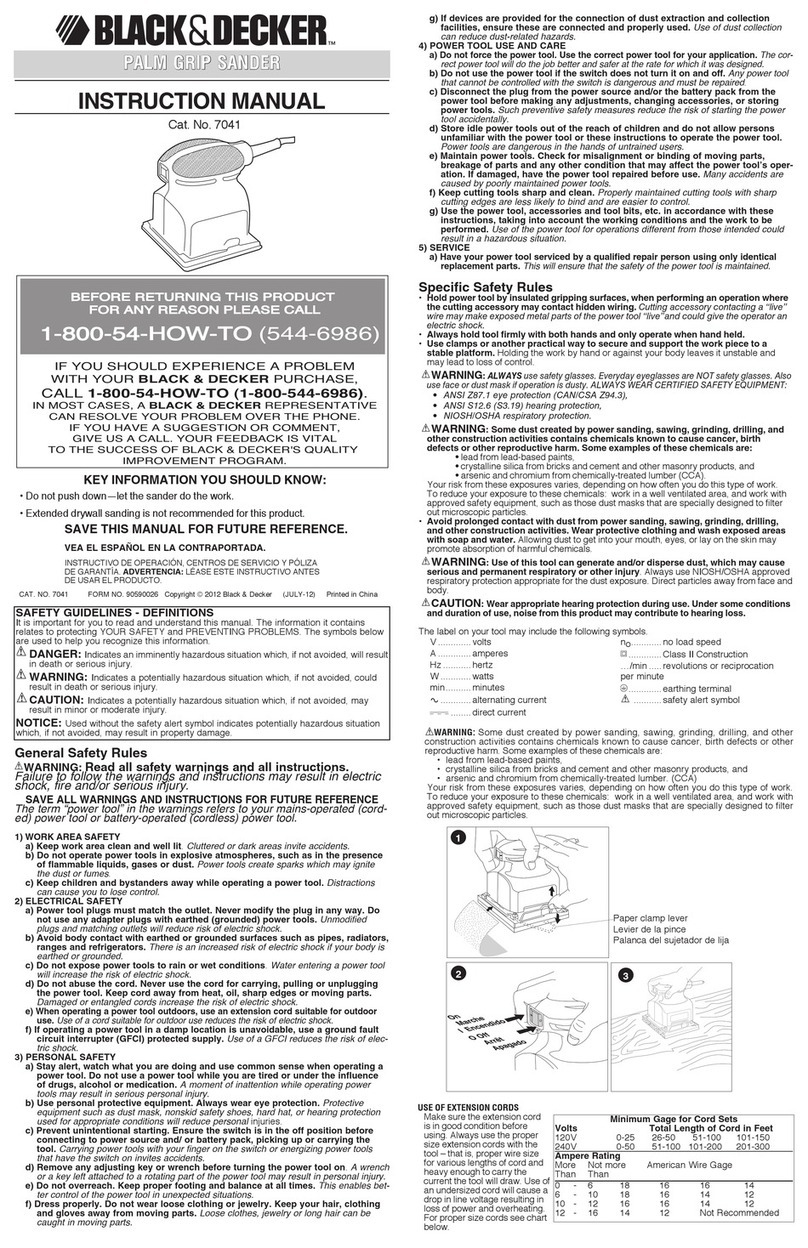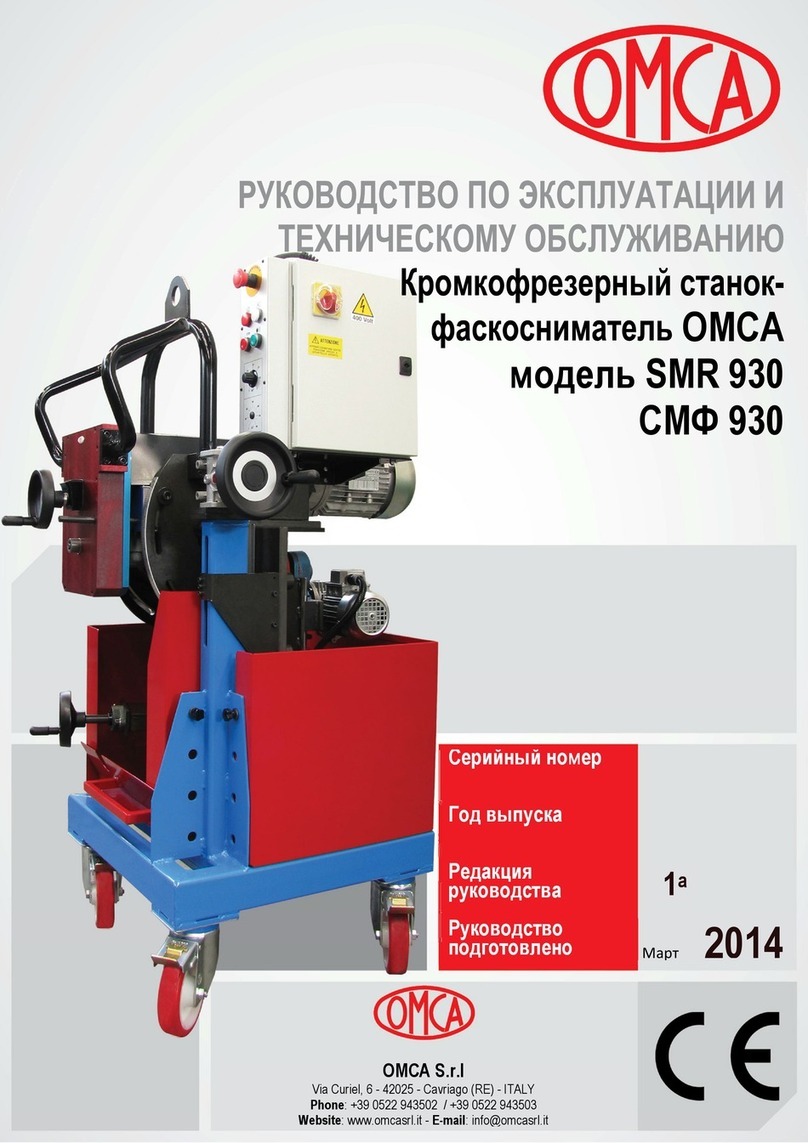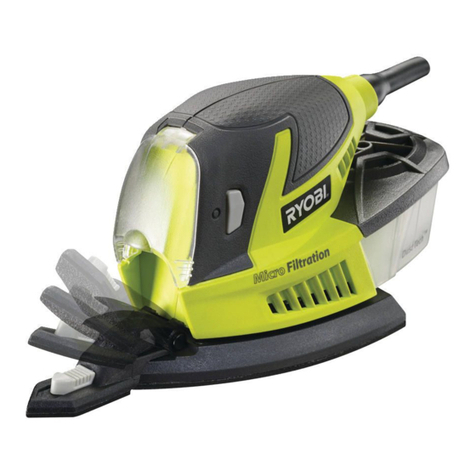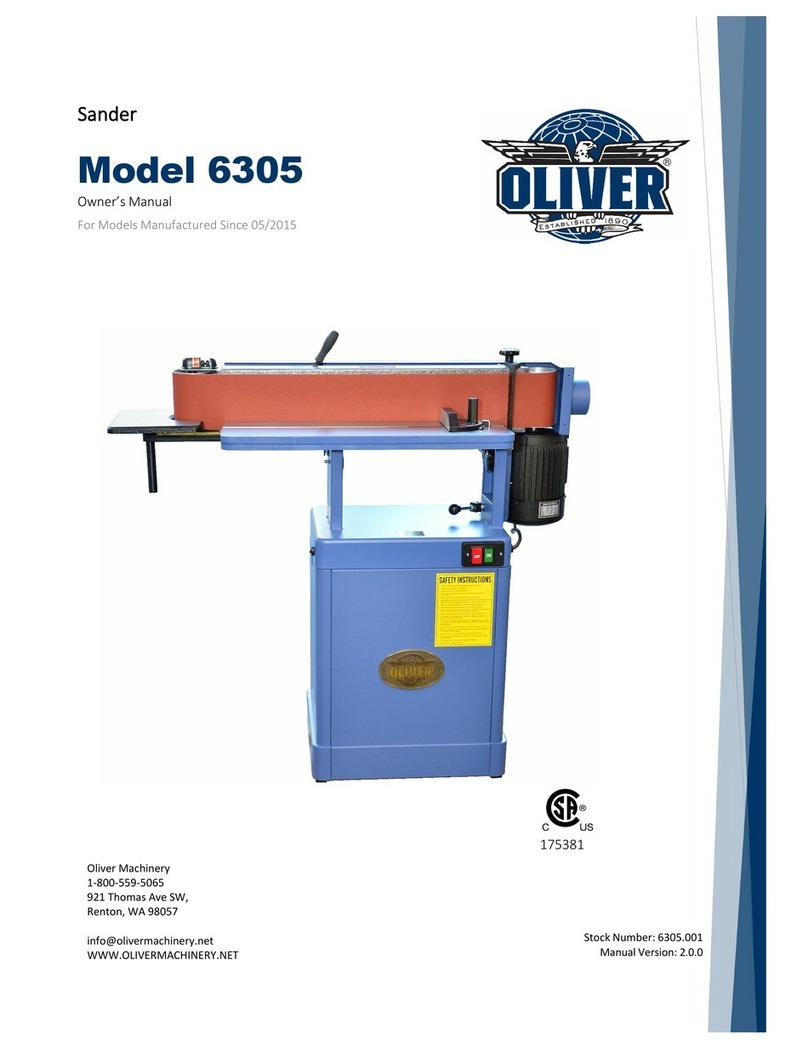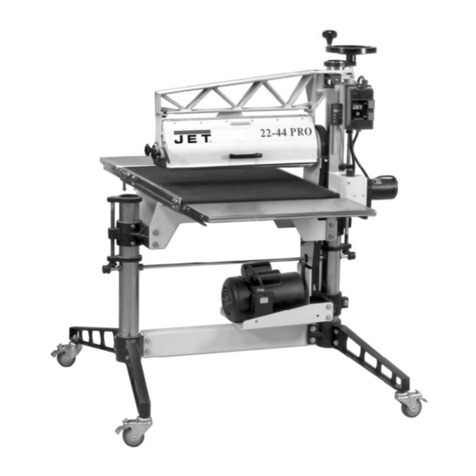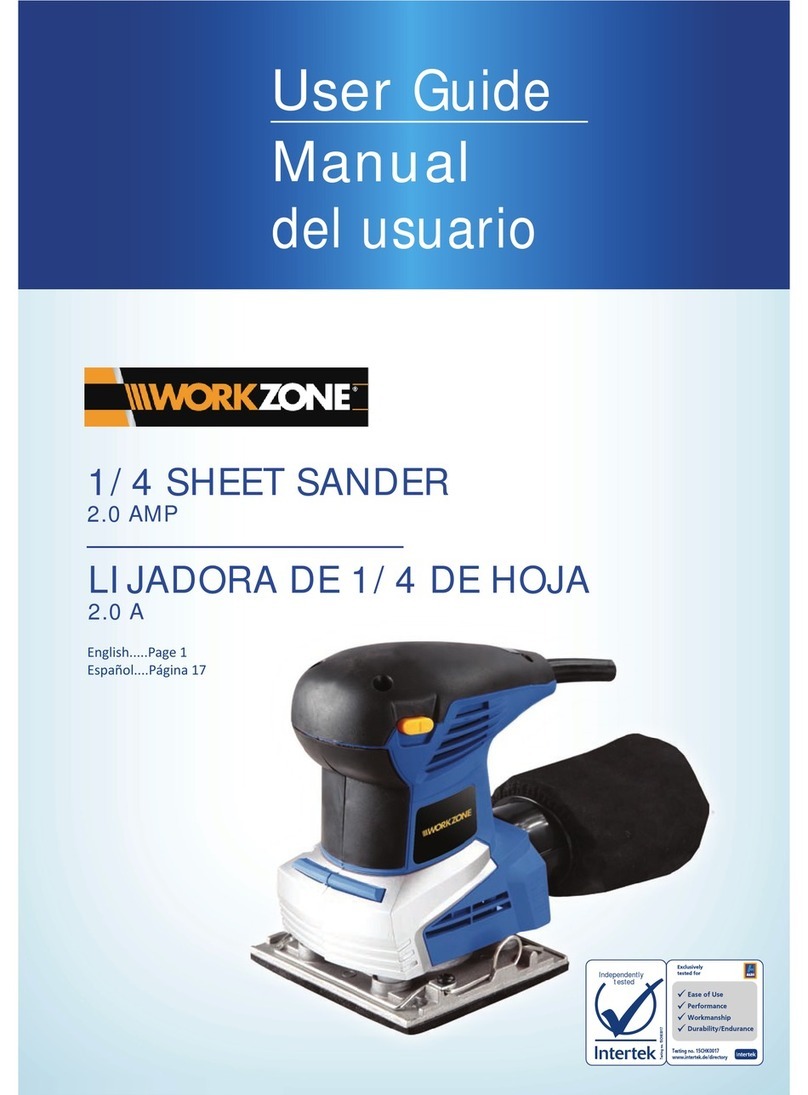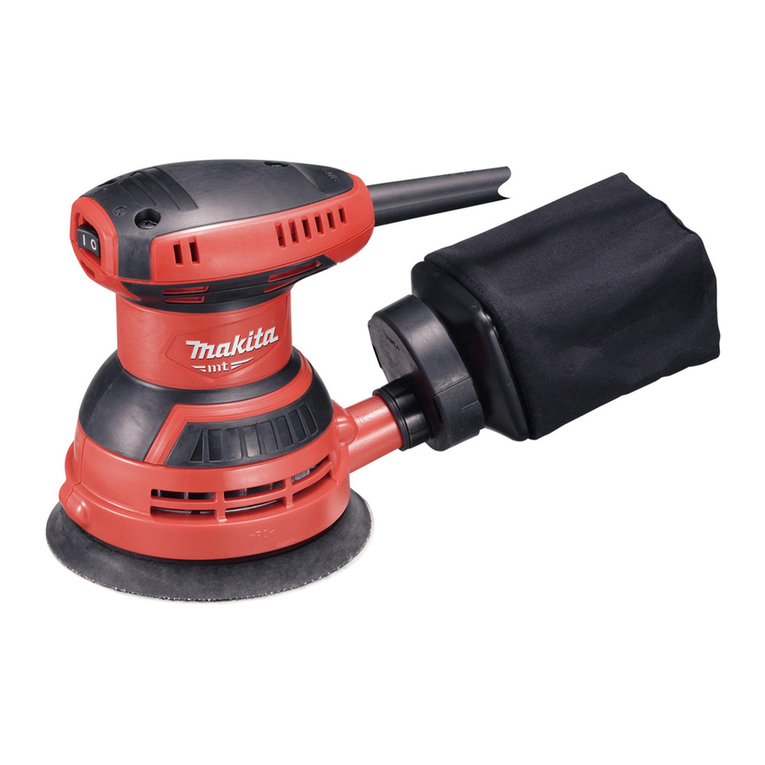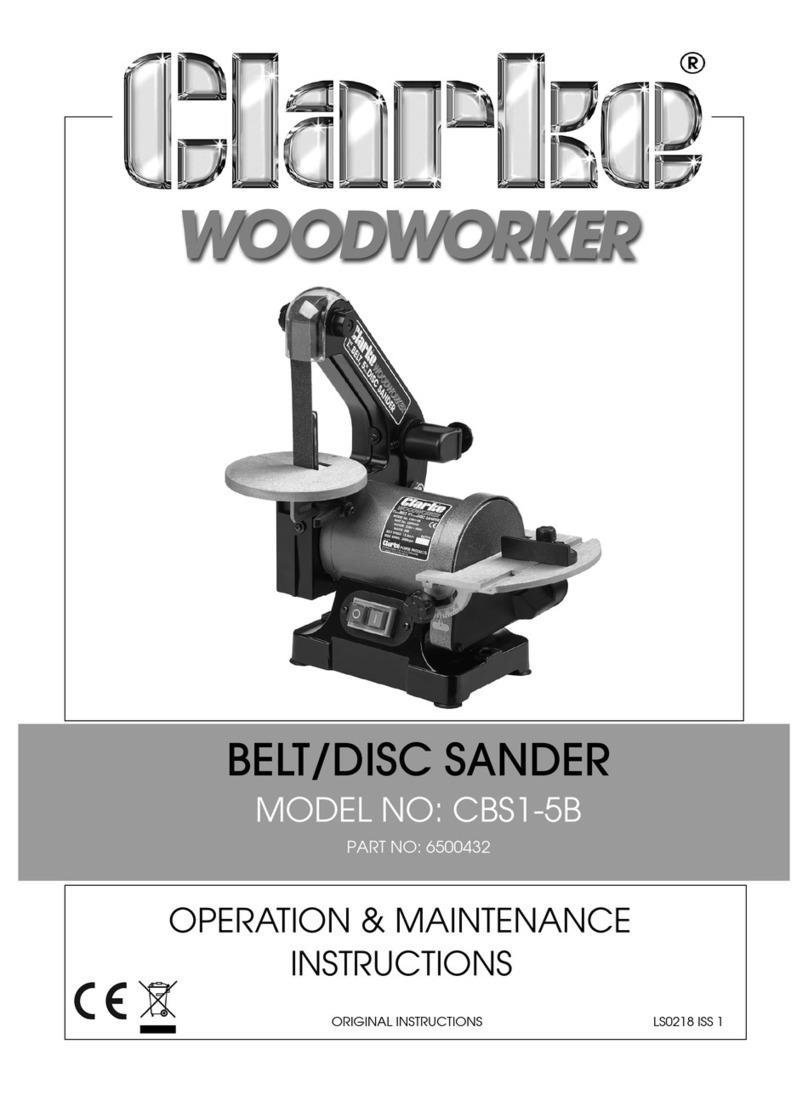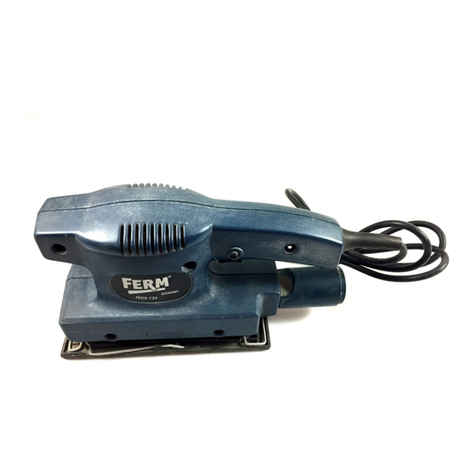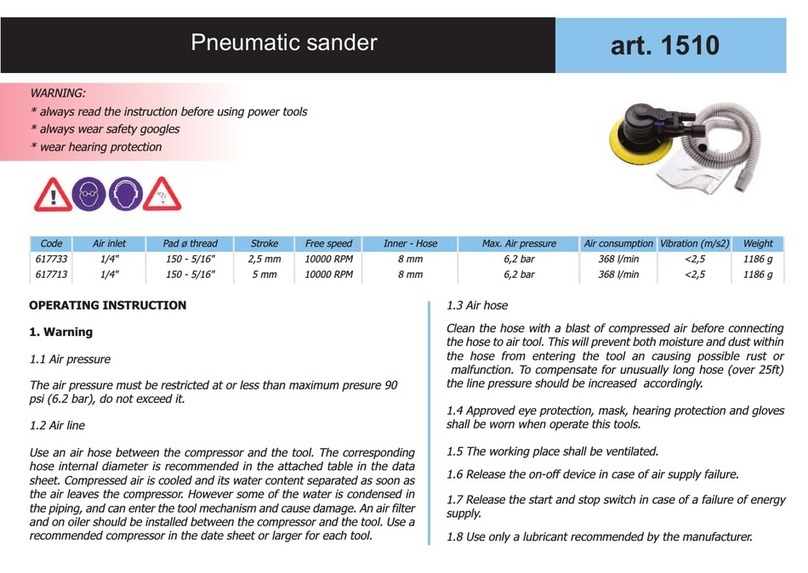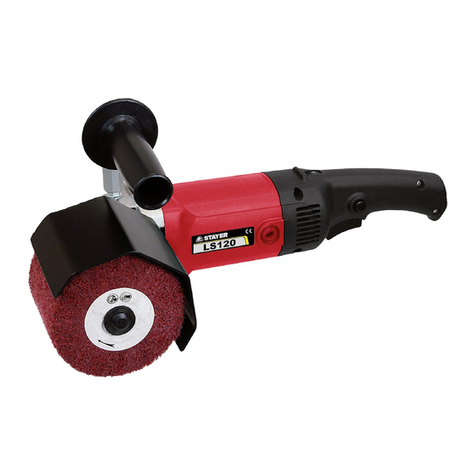
DIY 240W Random Orbit Sander
5
silverlinetools.com
General Safety
WARNING: Read all safety warnings and all instructions. Failure to follow the warnings and
instructions may result in electric shock, re and/or serious injury.
WARNING: This appliance is not intended for use by persons (including children) with reduced,
physical or mental capabilities or lack of experience or knowledge unless they have been given
supervision or instruction concerning use of the appliance by a person responsible for their safety.
Children must be supervised to ensure that they do not play with the appliance.
Save all warnings and instructions for future reference.
The term "power tool" in the warnings refers to your mains-operated (corded) power tool or battery-
operated (cordless) power tool.
1) Work area safety
a) Keep work area clean and well lit.Clutteredordarkareasinviteaccidents.
b) Do not operate power tools in explosive atmospheres, such as in the presence of
ammableliquids,gasesordust.Powertoolscreatesparkswhichmayignitethedustor
fumes.
c) Keep children and bystanders away while operating a power tool.Distractions can cause
you to lose control.
2) Electrical safety
a) Power tool plugs must match the outlet.Never modify the plug in any way. Do not use
any adapter plugs with earthed (grounded) power tools. Unmodiedplugsandmatching
outletswillreduceriskofelectricshock.
b) Avoid body contact with earthed or grounded surfaces, such as pipes,radiators, ranges
and refrigerators. Thereisanincreasedriskofelectricshockifyourbodyisearthedor
grounded.
c) Do not expose power tools to rain or wet conditions.Water entering a power tool will
increase the risk of electric shock.
d) Do not abuse the cord. Never use the cord for carrying,pulling or unplugging the power
tool. Keep cord away from heat, oil,sharp edges or moving parts. Damaged or entangled
cordsincreasetheriskofelectricshock.
e) When operating a power tool outdoors, use an extension cord suitable for outdoor use.
Useofacordsuitableforoutdoorusereducestheriskofelectricshock.
f) If operating a power tool in a damp location is unavoidable, use a residual current device
(RCD) protected supply.UseofanRCDreducestheriskofelectricshock.
3) Personal safety
a) Stay alert, watch what you are doing and use common sense when operating a power
tool.Donotuseapowertoolwhileyouaretiredorundertheinuenceofdrugs,alcohol
or medication. Amomentofinattentionwhileoperatingpowertoolsmayresultinserious
personal injury.
b) Usepersonalprotectiveequipment.Alwaysweareyeprotection.Protective equipment
suchasdustmask,non-skidsafetyshoes,hardhat,orhearingprotectionusedforappropriate
conditionswillreducepersonalinjuries.
c) Prevent unintentional starting.Ensure the switch is in the off-position before connecting
to power source and/or battery pack, picking up or carrying the tool.
Carryingpowertoolswithyourngerontheswitchorenergisingpowertoolsthathavethe
switchoninvitesaccidents.
d) Remove any adjusting key or wrench before turning the power tool on.Awrenchorakey
leftattachedtoarotatingpartofthepowertoolmayresultinpersonalinjury.
e) Do not overreach.Keep proper footing and balance at all times. This enables better control
ofthepowertoolinunexpectedsituations.
f) Dress properly. Do not wear loose clothing or jewellery. Keep your hair, clothing and
gloves away from moving parts. Looseclothes,jewelleryorlonghaircanbecaughtinmoving
parts.
g) If devices are provided for the connection of dust extraction and collection facilities,
ensure these are connected and properly used. Use of dust collection can reduce
dust-related hazards.
4) Power tool use and care
a) Do not force the power tool. Use the correct power tool for your application.The correct
powertoolwilldothejobbetterandsaferattherateforwhichitwasdesigned.
b) Do not use the power tool if the switch does not turn it on and off. Anypowertoolthat
cannotbecontrolledwiththeswitchisdangerousandmustberepaired.
c) Disconnect the plug from the power source and/or the battery pack from the power
tool before making any adjustments, changing accessories,or storing power tools. Such
preventivesafetymeasuresreducetheriskofstartingthepowertoolaccidentally.
d) Store idle power tools out of the reach of children and do not allow persons unfamiliar
with the power tool or these instructions to operate the power tool.
Powertoolsaredangerousinthehandsofuntrainedusers.
e) Maintain power tools. Check for misalignment or binding of moving parts, breakage of
parts and any other condition that may affect the power tool’s operation. If damaged,
have the power tool repaired before use. Many accidents are caused by poorly maintained
powertools.
f) Keep cutting tools sharp and clean. Properlymaintainedcuttingtoolswithsharpcutting
edgesarelesslikelytobindandareeasiertocontrol.
g) Use the power tool, accessories and tool bits etc.in accordance with these instructions,
taking into account the working conditions and the work to be performed. Use of the
powertoolforoperationsdifferentfromthoseintendedcouldresultinahazardoussituation.
5) Service
a) Haveyourpowertoolservicedbyaqualiedrepairpersonusingonlyidentical
replacement parts. Thiswillensurethatthesafetyofthepowertoolismaintained.
Sanding Tool Safety
WARNING!
• Hold the power tool by insulated handles or gripping surfaces only, because the sanding
belt/disc may contact its own cord.Cuttinga"live"wiremaymakeexposedmetalpartsofthe
powertool‘live’andcouldgivetheoperatoranelectricshock.
• Use clamps or another practical way to secure the workpiece to a stable platform. Holding
theworkpiecebyhandoragainstthebodymakesitunstableandmayleadtolossofcontrol.
• Recommendation that the tool always be supplied via a residual current device with a
rated residual current of 30 mA or less.
• If the replacement of the supply cord is necessary,this has to be done by the
manufacturer or his agent in order to avoid a safety hazard.
a. ALWAYSwearappropriateprotectiveequipment,includingadustmaskwithaminimum
FFP2 rating, eye protection and ear defenders
b. Ensureallpeopleinthevicinityoftheworkareaarealsoequippedwithsuitable
personalprotectiveequipment
c. Take special care when sanding some woods (such as beech,oak, mahogany and teak), as
the dust produced is toxic and can cause extreme reactions
d. NEVER use to process any materials containing asbestos. Consultaqualiedprofessional,if
youareuncertainwhetheranobjectcontainsasbestos
e. DO NOT sand magnesium or alloys containing a high percentage of magnesium
f. Beawareofpaintnishesortreatmentsthatmayhavebeenappliedtothematerial
that is being sanded. Many treatments can create dust that is toxic, or otherwise harmful.
Ifworkingonabuildingconstructedpriorto1960,thereisanincreasedchanceofencountering
lead-based paints
g. The dust produced when sanding lead-based paints is particularly hazardous to children,
pregnant women, and people with high blood pressure. DONOTallowthesepeoplenearto
theworkarea,evenifwearingappropriatepersonalprotectiveequipment
h. Whenever possible, use a vacuum dust extraction system to control dust and waste
i. Be especially careful when using a machine for both wood and metal sanding. Sparks
from metal can easily ignite wood dust. ALWAYS clean your machine thoroughly to reduce
theriskofre
j. Emptythedustbagorcontainer(whereapplicable)frequentlyduringuse,beforetaking
breaks and after completion of sanding. Dustmaybeanexplosionhazard.DONOTthrow
sandingdustintoanopenre.Spontaneouscombustionmayoccurwhenoilorwaterparticles
comeintocontactwithdustparticles.Disposeofwastematerialscarefullyandinaccordance
withlocallawsandregulations.
k. Work surfaces and sandpaper can become very hot during use. If there is evidence of
burning (smoke or ash), from the work surface,stop and allow the material to cool. DO
NOTtouchworksurfaceorsandpaperuntiltheyhavehadtimetocool
l. DO NOT touch the moving sandpaper
m. ALWAYS switch off before you put the sander down
n. DO NOT use for wet sanding.Liquids entering the motor housing can cause severe electric
shocks
o. ALWAYS unplug the sander from the mains power supply before changing or replacing
sandpaper
p. Even when this tool is used as prescribed it is not possible to eliminate all residual risk
factors. If you are in any doubt as to safe use of this tool, do not use it
870944/951405_Manual.indd 5 04/07/2019 11:03
